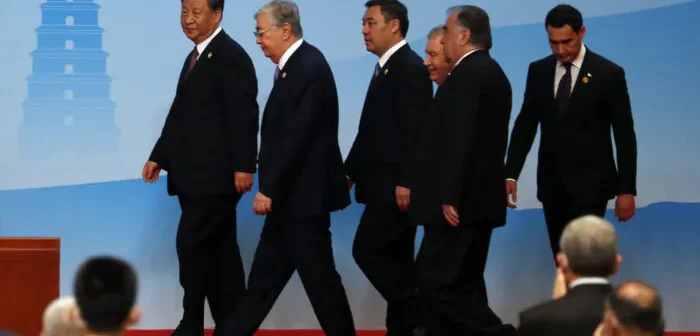China hosted a Central Asia Summit in its historic city of Xi’an on May 18 and 19, one day before this year’s Group of Seven (G-7) Summit in Japan’s Hiroshima from May 19 to 21.
The Chinese leader Xi Jinping met with heads of state from Kazakhstan, Kyrgyzstan, Tajikistan, Turkmenistan, and Uzbekistan in one-on-one meetings, touting “long-lasting friendship” with these former Soviet Union republics.
Xi’an, originally known as Xianyang and Chang’an, was the capital of several powerful Chinese dynasties, including the Qin, Han, and Tang. It was the starting point of the ancient Silk Road during the Han Dynasty.
China analysts believe that Xi intentionally picked Xi’an to hold the Central Asia Summit as an open challenge to the G-7 summit and as a platform to show his leadership in an international body.
Central Asia, also known as Middle Asia, includes the five former Soviet republics and covers a vast region of Asia that stretches from China’s eastern borders to the Caspian Sea in the west, Afghanistan in the south, and Russia in the north.
A strategic passage for Beijing, Central Asia used to be regarded as the backyard of Russia. Chinese freight trains run between China and Europe and crisscross Central Asia. According to state-media Xinhua News Agency, over 1,100 China-Europe freight trains were dispatched from Xi’an in the first quarter of this year.
Beijing is attempting to strengthen its ties with these five countries as Russia’s influence is waned by its war efforts in Ukraine. Central Asian countries, on the other hand, are looking at China as their new economic and trade source, analysts say.
However, the summit, which is limited to Central Asian countries, reveals Xi’s failure in challenging the West, said China affairs commentator Tang Jingyuan on May 20.
“Xi Jinping has suffered a significant setback in his regional expansion efforts in East Asia and Southeast Asia. A notable event was when countries such as Japan, South Korea, the Philippines, and others clearly aligned themselves with the United States, effectively forming a blockade against China along the first island chain,” Tang said in his YouTube program.
“As a result, Xi can only instinctively strengthen his rear area, which is Central Asia.”
‘Using Each Other for Their Own Ends’
China has been expanding its influence in central Asia through economic, technological, and cultural cooperation, under the nose of Russia even when Russia had a predominant influence on these countries before the Ukraine war.
“China and Central Asia are only using each other for their own ends, such as trade relations,” said China affairs commentator Li Linyi in an interview with the Chinese language edition of The Epoch Times on May 17.
According to Chinese Communist Party (CCP) mouthpiece People’s Daily, China’s total trade with the five Central Asian countries reached a record $70 billion last year. The trade in the first four months of 2023 was $24.7 billion, representing an increase of 37.3 percent year on year.
China has also invested billions of dollars in developing natural gas resources in Central Asia.
By the end of March, China’s cumulative direct investment in the five Central Asian countries exceeded $15 billion. One of the investment projects is the Central Asia–China gas pipeline, a natural gas pipeline system from Central Asia to China’s western Xinjiang region connecting natural gas from Turkmenistan, Uzbekistan, and Kazakhstan to China’s domestic grid. There are three parallel lines in operation, with a designed annual throughput of 60 billion cubic meters, according to Xinhua.
Another China commentator Cai Shenkun noted that central Asian countries rely on China for investment dollars and seek access to China’s market.
“These [Central Asian] countries are all China’s close neighbors, and when China’s energy procurement capacity and investment efforts tilt towards these countries, they will significantly benefit,” Cai told the Chinese language edition of The Epoch Times in an interview on May 17.
However, the CCP’s investments in the region are causing widespread criticism domestically, as Chinese citizens feel overlooked by the central government. On May 19, Xi reportedly announced providing a total of 26 billion yuan ($3.8 billion) in financing support and grants to Central Asian countries amid China’s own economic downturn, high unemployment rate, aging population crisis.
Among the five Central Asian countries, Kazakhstan holds a dominant position in terms of its economy, accounting for 60 percent of the total GDP of the five countries. Xi Jinping first proposed the Belt and Road Initiative in Kazakhstan in September 2013. President of Kazakhstan Kassym-Joomart Tokayev arrived in Xi’an on May 17, one day ahead of the heads of the other states.
Despite China’s efforts to strengthen its ties with Central Asia, Cai believes that the China-Central Asian Summit is incapable of challenging the status of the G-7 Summit. In terms of political influence and economic strength, the Central Asian countries are not on the same level.
Feng Chongyi, associate professor of China studies at the University of Technology Sydney, agreed with Cai.
“The CCP’s alliance simply cannot compare with the Western democratic alliance,” he said.
Amid China’s increasing aggression, Europe and the United States “are changing their China policies of the previous decades,” Cai told The Epoch Times.
The G-7 leaders discussed the threat posed by China’s ruling CCP at the summit. The G-7 Hiroshima Leaders’ Communiqué released on May 20 outlined up nine points in order to address the risks posed by the CCP. It voiced the concerns among the world’s advanced democracies on the CCP’s human rights record, the CCP’s military activities in the South China Sea, the stability of Taiwan, and the CCP’s coercion in the East and South China Seas.

